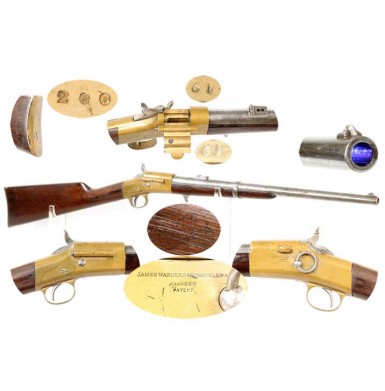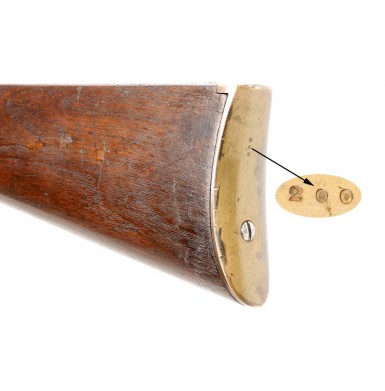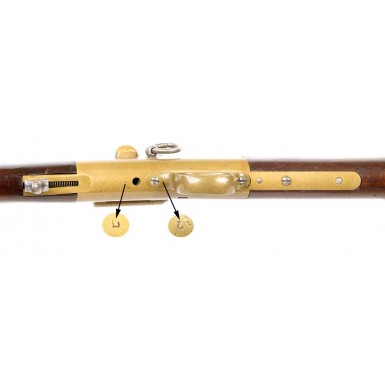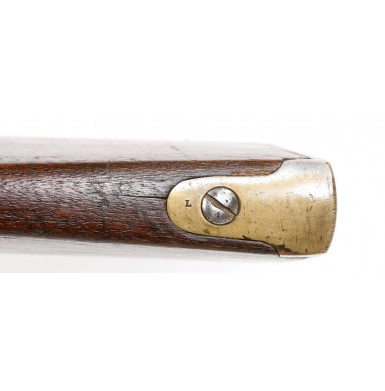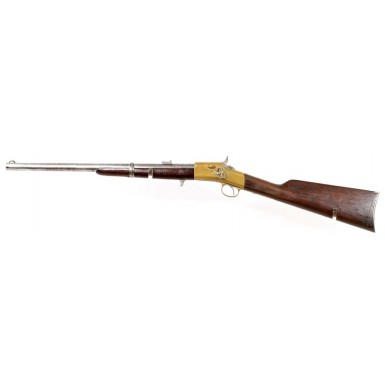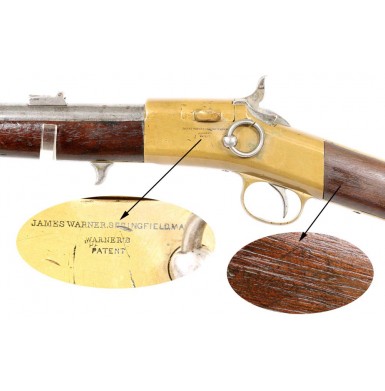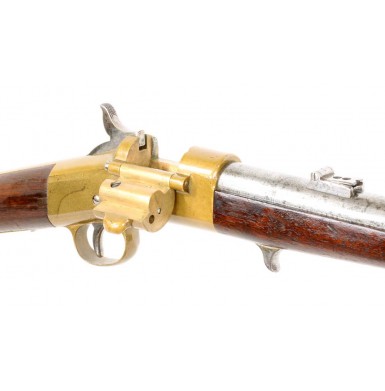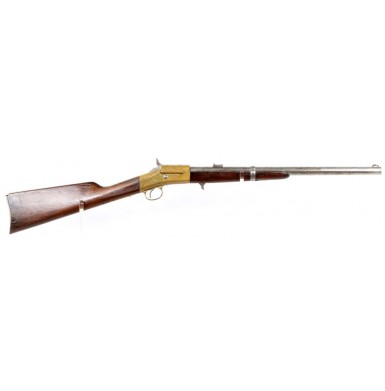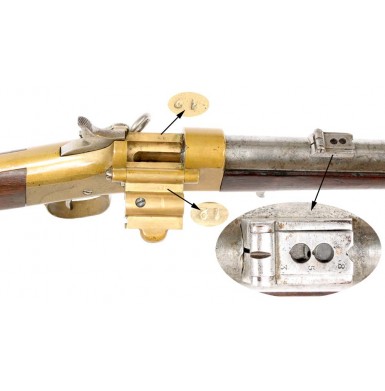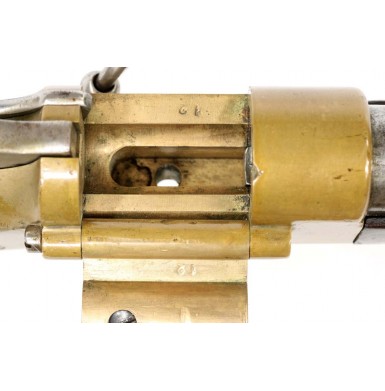The Warner Carbine is a great example of the many styles of innovative, breechloading, metallic cartridge arms that were procured in relatively small numbers by the US Ordnance Department during the American Civil War. The Warner Carbine was the brainchild of James Warner of Springfield, MA. Warner had a long history of employment in the firearms industry and had at one time worked at Eli Whitney’s factory in Whitneyville, Connecticut, where he was involved with the production of the Walker pattern Colt revolvers that Whitney produced for Colt. He subsequently went to work for the newly formed Springfield Arms Manufacturing Company of Springfield, MA. Warner served as factory superintendent and sale agent for the company and contributed his designs in the form of several percussion revolving rifles. Springfield Arms Company also produced several models of percussion revolvers in a variety of calibers, some with manually revolved cylinders and some with self-rotating, single action lock mechanisms. In 1864, Warner received two patents related to his newly designed carbine. The carbine was a single shot, breech loading, metallic cartridge gun. It had a brass frame, a 20” round iron barrel and brass furniture. The Warner holds the distinction of being the only brass frames carbine that was purchased by the Ordnance Department during the American Civil War, with the exception of the Henry, which was considered a repeating rifle. The carbine had a walnut buttstock and a separate “splinter” walnut forend that was secured with a single barrel band and a single screw. The gun was chambered for a proprietary .50-rimfire cartridge and was loaded through a hinged breechblock on the top of the receiver. His patent of February 23, 1864 covered the loading aperture in the frame of his carbine. A second patent, issued on December 27, 1864 covered the firing pin in the breechblock that was struck by the hammer when the trigger was pulled. The hammer nose engaged a slot in the breechblock when it fell, which not only hit the pin, but also held the block closed while firing. Warner’s system was very simple, as the hinged breechblock was only held in place by the hammer nose. Placing the carbine on half cock allowed the block to open by pivoting it to the right. Empty cartridges were extracted with the help of a manual extraction lever under the frame, similar to those found on Ballard rifles and carbines. The extractors were notoriously weak and often did not exert enough force to remove swollen cartridge cases from the breech. Apparently, Warner’s design looked good enough on paper that on January 13, 1864, the US Ordnance Department agreed to an initial contract for 1,000 of the carbines at $18.00 each. The order was received more than a month before Warner would be granted his first patent on the design. The sample carbine was delivered 11 days later, and the first 200 guns of the contract were delivered on March 31, 1864. Warner delivered 300 more on April 25 and the balance of 500 on June 23. Apparently, the Ordnance Department was sufficiently satisfied with the initial deliveries that in October of 1864 they accepted an additional 500 carbines and on December 7, 1864 they contracted for 2,500 more of the guns. While the first 1,501 carbines had been manufactured by Warner’s Springfield Arms Company, the Greene Rifle Works of Worchester, MA, manufactured the guns for the second contract. The carbines produced by Springfield were in the original .50 Warner caliber, but the guns produced by Greene were in the newly adopted .50 Government Rim Fire caliber (.50 Spencer or “56-50”). There were some other changes as well. The troublesome extractor was modified in order to make it more functional, and the simple eye-bolt sling ring of the 1st contract carbines was replaced by a more conventional sling bar and ring. The deliveries under this 2nd contract began on February 2, 1865, when the first 500 carbines were delivered. Additional deliveries were made on February 18 (500), February 27 (800) and March 15 (700). In total, Warner delivered of 4,001 carbines to the Ordnance Department in 15 months, a feat not matched by many patent arms manufactures that contracted with the US government during the Civil War. The majority of the Warner carbines were issued to two US volunteer cavalry regiments, the 1st Wisconsin Cavalry and the 3rd Massachusetts Cavalry. The 1st Wisconsin was formed early in the war and spent the first year or so in the Missouri area. They then joined the Union armies in Tennessee and participated in every major western theater engagement from the Tullahoma Campaign through Chickamauga, the Atlanta Campaign and the Nashville Campaign. The 3rd Massachusetts was a late war regiment that cut its teeth on the Red River Campaign in Louisiana and was subsequently transferred to the Eastern Theater where they participated in Sheridan’s Shenandoah Valley Campaign. After the war, the Warner Carbines remained in limited use through 1867. The majority of the carbines were sold off to Schuyler, Hartley and Graham in 1870, when the firm purchased 2,492 of the guns and sold them to the French for the Franco-Prussian War. This is one reason that the guns are relatively scarce today. The remaining carbines were probably sold off to various retailers for resale to the public during the latter part of the 1870s. This no doubt accounts for the numerous extant examples that are found with checkered wooden stocks, an enhancement probably added by civilian retailers to make the obsolete guns more attractive and marketable as sporting arms.
This is a VERY GOOD+ example of one of a 1st Contract Warner Carbine. The gun may be one of the first 200 guns that were delivered by Warner and Springfield Arms on March 31, 1864. 1st contract Warner carbines are typically marked on the left side of the brass frame:
JAMES WARNER. SPRINGFIELD, MASS
WARNER’S
PATENT
The carbines are serial numbered on the bottom of the buttplate and assembly numbered under the breechblock for the early guns, with later guns serial numbered under the breech block. This gun is serial numbered 200 on the bottom of the buttplate. It is also clearly marked with the standard three-line patent markings on the reverse of the receiver. Several sources, ranging from Flayderman’s Guide to Antique American Arms to John D. McAulay’s Carbines of the Civil War note that the first 200 carbines appear to have been delivered without receiver markings, as the patents were not granted in time for the initial production guns to be marked. They both also note that these very early guns are serial numbered on the toe of the buttplate, not on the breechblock. Interestingly, as this gun is serial numbered 200 on the buttplate, it suggests that maybe the serial numbers were not applied in consecutive order, or that Warner was pulling a fast one with his serial numbering system. I previously owned an unmarked 1st Model Warner that was serial numbered “2565” on the toe of the butt. If the earliest guns were unmarked, then this high number may have been applied in an attempt to mislead the Ordnance Department. This type of serial numbering was a fairly common gambit in 19th century arms making as it made a model appear to be more successful than it really was. In addition to the serial number and patent information the gun is marked in a number of places with a small L sub-inspection mark, and with a weak script CSL cartouche on the reverse wrist. This is the mark of Ordnance Department civilian sub-inspector Chester S. Leonard. Leonard inspected all 1,501 of the 1st Model (Springfield) produced Warner carbines.
The carbine is 100% complete and correct in every way. The metal of the gun is mostly smooth throughout, with only some scattered pinpricking and very light peppering noted, along with some minor pitting around the muzzle and breech areas. The barrel has been cleaned to bright at some point in time and has mellowed to a bright pewter color. The barrel now has a somewhat mottled appearance due to scattered patches of darker surface oxidation and discoloration. The bore of the carbine is in about VERY GOOD+ to NEAR FINE condition. The bore is mostly bright and has strong rifling the entire length of the barrel. The bore shows some lightly scattered pitting, but remains in very nice condition. The brass frame has a lovely, uncleaned butterscotch patina that is very attractive. The buttplate and other brass furniture have the same matching, deeply bronzed patina as well. The hinged breechblock operates exactly as it should and moves smoothly. The block and receiver are both assembly numbered 12. The action of the carbine is excellent and fully functional, and the gun remains in mechanically fine condition. The extractor under the barrel still functions smoothly as well. The carbine retains its original multi-aperture flip up rear sight, as well as the original front sight. The original eyebolt sling ring is present in the wrist of the carbine as well. The stock and forend of the carbine rate about GOOD+ to NEAR VERY GOOD. They both show a substantial number of bumps, dings and mars from service and use. The thin, “splinter” style forend shows a couple of very small chips missing as well. There is also some minor cracking and minor wood loss around the extractor mounting housing. The buttstock shows a number of minor surface grain cracks, most of which are the result of stress around the sling ring eyebolt mount and at the frame juncture, a notorious weakness in the carbine’s design. Warner carbines are normally found with numerous cracks in the wrist area of the stock. A couple of larger cracks are present as well and show old repairs. The buttstock has been light sanded and shows some added finish, probably from when the cracks were attended to. However, compared to most Warner carbines, the stock remains very good and amazingly remains quite solid with a partially visible cartouche. The buttstock also shows some lightly carved initials on the reverse.
Overall, this is a very attractive example of a fairly scarce and desirable 1st Model (Springfield) Warner’s Patent Carbine. The gun remains in complete and original condition with no major repairs or replacement parts. The frame and buttplate have a wonderful, untouched patina, and the stock (although well-worn from issue and use with some minor crack repairs) remains very attractive as well. These earliest guns are from the first deliveries under the first contract are quite scarce, even more difficult to find than a standard production Warner carbine produced by the Greene Rifle Works. With more than half of the all Warner Carbines produced having been sent to France for the Franco Prussian War, it is hard to find a nice example of these guns for sale at a reasonable price. This is a really nice, complete, early gun for a fair price, that will be a great addition to your carbine collection.
SOLD

